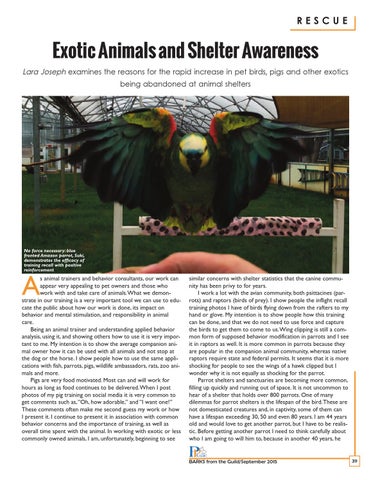RESCUE
Exotic Animals and Shelter Awareness
Lara Joseph examines the reasons for the rapid increase in pet birds, pigs and other exotics being abandoned at animal shelters
No force necessary: blue fronted Amazon parrot, Suki, demonstrates the efficacy of training recall with positive reinforcement
A
s animal trainers and behavior consultants, our work can appear very appealing to pet owners and those who work with and take care of animals. What we demonstrate in our training is a very important tool we can use to educate the public about how our work is done, its impact on behavior and mental stimulation, and responsibility in animal care. Being an animal trainer and understanding applied behavior analysis, using it, and showing others how to use it is very important to me. My intention is to show the average companion animal owner how it can be used with all animals and not stop at the dog or the horse. I show people how to use the same applications with fish, parrots, pigs, wildlife ambassadors, rats, zoo animals and more. Pigs are very food motivated. Most can and will work for hours as long as food continues to be delivered. When I post photos of my pig training on social media it is very common to get comments such as, “Oh, how adorable,” and “I want one!” These comments often make me second guess my work or how I present it. I continue to present it in association with common behavior concerns and the importance of training, as well as overall time spent with the animal. In working with exotic or less commonly owned animals, I am, unfortunately, beginning to see
similar concerns with shelter statistics that the canine community has been privy to for years. I work a lot with the avian community, both psittacines (parrots) and raptors (birds of prey). I show people the inflight recall training photos I have of birds flying down from the rafters to my hand or glove. My intention is to show people how this training can be done, and that we do not need to use force and capture the birds to get them to come to us. Wing clipping is still a common form of supposed behavior modification in parrots and I see it in raptors as well. It is more common in parrots because they are popular in the companion animal community, whereas native raptors require state and federal permits. It seems that it is more shocking for people to see the wings of a hawk clipped but I wonder why it is not equally as shocking for the parrot. Parrot shelters and sanctuaries are becoming more common, filling up quickly and running out of space. It is not uncommon to hear of a shelter that holds over 800 parrots. One of many dilemmas for parrot shelters is the lifespan of the bird. These are not domesticated creatures and, in captivity, some of them can have a lifespan exceeding 30, 50 and even 80 years. I am 44 years old and would love to get another parrot, but I have to be realistic. Before getting another parrot I need to think carefully about who I am going to will him to, because in another 40 years, he BARKS from the Guild/September 2015
39
